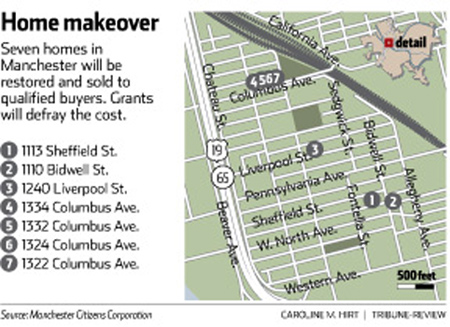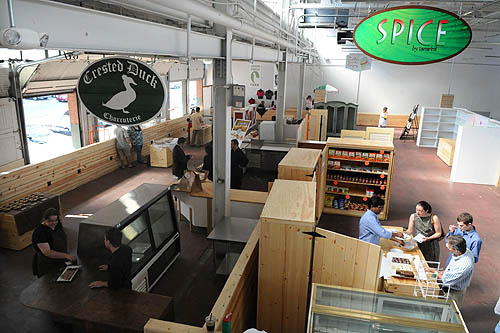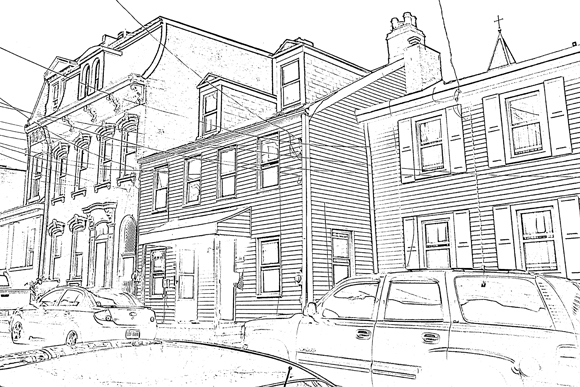
Category Archive: Neighborhood Development
-
Work on Former Hollow Tavern Progressing
By Jewels Phraner
LIGONIER ECHO
Thursday, September 2, 2010
Fred Haeflein works on reviving the Hollow Tavern on Route 30 outside of Ligonier. Jared Wickerham | Tribune-Review
Saving Sleepy Hollow hasn’t gone exactly the way owner Fred Haeflein expected.
He’s had a skilled crew at work rebuilding the log landmark, but now he’s looking for a good chef and manager to operate the restaurant.
After an arson destroyed the building in February 2008, causing so much damage that Unity code enforcement officer Merle Musick condemned the property, Haeflein bought it with the intention of restoring it.
Financial troubles plagued the project early on, and this summer Haeflein said he has struggled to find the right person to run the restaurant. Although he has fond childhood memories of the restaurant, he has no interest in running the facility once it’s finished.
“I don’t cook. I’m not a restaurant manager,” Haeflein said. “I build things. I save things. I just want this building here.
“I need a good restaurateur – no, I need a great restaurateur – to keep this place running for a long time,” he said.
When the project ran into financial problems in early 2007, The Progress Fund, a Greensburg-based nonprofit lending organization approached Haeflein about a loan.
“That valley is so great. So many people enjoy driving through it. And we thought it would be a nice venue for people to stop and enjoy the valley,” said David Kahley, chief executive officer for the organization, which focuses on tourism-oriented projects.
Project loan officer Bob Patter said that while people might not see progress as they drive by the building, that doesn’t mean work isn’t being done behind the scenes.
“It’s still a very active project,” he said. “Fred is moving forward with it. Perhaps not at the pace everyone would like to see, but he’s trying to find the right person to run the restaurant for him.”
Haeflein said he expected to buy exterior logs for the building. But he wasn’t able to find the correct size and had to custom-make them instead.
“I wanted them to be as close to the original (Sleepy Hollow) as possible, and you just can’t buy logs that width anymore,” he said.
So Haeflein spent part of the summer using an ancient mill in his New York shop to cut logs, then transporting them to Ligonier.
“This is probably a lot like how the original logs were made,” he said. “It’s a pure miracle that (the mill) actually worked. That mill is probably as old as this building and hasn’t been used in 20 years.”
For now, only a few logs are secured to the building, but Haeflein said he will be back to finish the job soon.
Kelly’s Sleepy Hollow LLC was formed by Haeflein and his brother, Rich, who have been restoring the landmark west of Ligonier for about two years.
Edgar Wiltrout of Ligonier is serving a 10- to 28-year prison sentence for torching the restaurant and tavern on Feb. 23, 2008, because the former owner owed Wiltrout $1,000 and fired his girlfriend as a cook.
-
7 Homebuyers Sold on Manchester Vision
By Adam Brandolph
PITTSBURGH TRIBUNE-REVIEW
Thursday, September 2, 2010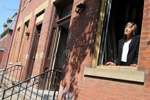
Linda Nelson, chairwoman of the Manchester Citizens Corporation, inspects one of the properties being restored on Columbus Avenue in Manchester. The home was purchased as part of the Great House Sale. Jasmine Goldband | Tribune-Review
For the first time in years, Anthony Clark sees a reason to invest in his North Side neighborhood.
“Manchester is really starting to get going, and after 15 years of renting, I think it’s a good time,” said Clark, 44. “I think we’re about to see some really great things.”
For years, the city demolished vacant homes in Manchester, turning usable buildings into weed-filled lots that became overrun with graffiti and trash. The vacant lots made selling homes difficult, and people living there say the community suffered despite the fact that police records show the number of crimes fell by nearly half over the past decade.
“When you have a tooth out, the disease begins to spread,” said Linda Nelson, chairwoman of the Manchester Citizens Corporation, a community group founded in 1965 that helped spur more than $40 million in developments and initiatives. “If (buildings) come out, it’s definitely a hindrance. If we can renovate them, it’s a plus.”
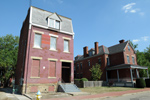
An abandoned structure (left) on the 1100 block of Bidwell Street in Manchester is one of several slated for rehabilitation. Jasmine Goldband | Tribune-Review
With the group’s managing director Stanley Lowe urging the city to save buildings from demolition, the wrecking ball slowed. Along with the Pittsburgh History & Landmarks Foundation, it identified 110 buildings that should be saved, 63 of which are considered a priority.
Lowe said he reminded members of the city’s Historic Review Commission about the neighborhood’s rich architectural and cultural heritage, which helped Manchester achieve city and national historic status in 1979.
“Once you tear down the building, you can never go back,” Lowe said.
In October, the citizens’ group showcased seven homes to be restored by March. More than 100 people, some from as far away as Venezuela and Colombia, attended a two-day session that included a seminar educating them about how to buy one of the homes.
Twenty-five people put down $1,500 deposits, and seven qualified buyers were chosen at random to buy the homes. The rest were put on a waiting list for future restorations.
“The homes were a terrible mess,” Nelson said. “But the people who came in saw our vision.”
The cost to restore each home will range from $150,000 and $450,000, but they will sell for $90,000 to $200,000.
Incentives totaling $2 million for the buyers will be paid by grants from the city’s Urban Redevelopment Authority, the federal Department of Housing and Urban Development, Allegheny County, the Pittsburgh History & Landmarks Foundation’s Landmarks Community Capital Corporation and the Allegheny Foundation.
City Councilman R. Daniel Lavelle, whose district includes Manchester, said the strategy “fits the city’s economic reality.”
“The city can’t afford to do it all at once, so (the citizens’ group has) identified key properties they want to save,” Lavelle said. “I think it’s a tremendous project.”
Preserving the “architectural fabric” of the historic district has been ongoing since the 1970s, said Arthur Ziegler, president of the landmarks foundation.
Rob Stephany, executive director of the redevelopment authority, said the restorations are a “really bright strategy,” especially because they’re near construction at Columbus Square, a $15 million, 31-home development on four acres.
“Manchester has everything working for it,” he said.
-
Downtown’s EQT Plaza No Longer on the Block
‘Recapitalization’ shinier than sellingWednesday, September 01, 2010By Mark Belko, Pittsburgh Post-GazetteThe owner of one Downtown building has removed its “for sale” sign.
Rather than sell, New York-based Blackstone Group has decided to retain ownership of EQT Plaza, formerly known as Dominion Tower, and refinance its debt.
“They just decided with the way the markets are today, a recapitalization was a better option for them,” said Gerard Sansosti, executive managing director of HFF Inc. in Pittsburgh, which was marketing the building for sale.
Aaron Stauber, president of New York-based Rugby Realty, which has extensive property holdings in Pittsburgh, said refinancing was an attractive option for building owners these days because of very low interest rates. One advantage to refinancing rather than selling, he noted, is that the owner does not have to pay capital gains taxes.
HFF had announced in February that it was putting the 32-story office building, now the headquarters of EQT Corp., up for sale on behalf of Blackstone, which bought it for $45 million through a sheriff’s sale in 2005.
While HFF had received offers for the 23-year-old building, located on Liberty Avenue, Mr. Sansosti said Blackstone ultimately decided not to sell.
“I think it’s going to be off the market for a while,” he said.
As of February, the 615,942-square-foot office tower was about 96 percent leased. EQT moved into the building from the North Shore last year.
EQT Plaza was one of a handful of high-profile buildings Downtown to go up for sale this year, sparking a wave of publicity and even inquiries from city hall about the reasons for the moves.
Others on the market include the landmark Macy’s department store (formerly Kaufmann’s); the four-building Gateway Center complex, the linchpin of the city’s first renaissance; the Henry W. Oliver Building; the Regional Enterprise Tower, formerly the Alcoa Building; and American Red Cross of Southwestern Pennsylvania building, Boulevard of the Allies.
-
City’s Newest Indoor Market Opens in Strip Next Week
Wednesday, September 01, 2010By Diana Nelson Jones, Pittsburgh Post-GazetteWhen the Pittsburgh Public Market in the Strip opens Friday, patrons will see some tried-and-true faces — La Prima Coffee, the Common Plea and Fudgie Wudgie among them.
But the new indoor market in the Produce Terminal Building on Smallman Street marks the retail debut of a number of the 43 vendors, whose wares will include organic produce, coffee, specialty meats, pastries, Indian food, pierogies, organic teas, local wines, micro brewed beer, skin care products, knitted goods and jewelry.
The Produce Terminal was built in 1926 by the Pennsylvania Railroad. The market house, located between 16th and 17th Streets, features horizontal roof-line skylights and doors that open for a river view. It will be open Fridays from 9 a.m. to 7 p.m., Saturdays from 9 a.m. to 5 p.m. and Sundays from 10 a.m. to 4 p.m. The grand opening festivities are Sept. 10-12.
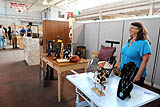
Debbie Jacknin of Jenn's Jems displays her jewelry and other items in her booth at the new Pittsburgh Public Market in the Strip District on Tuesday. Robin Rombach/Post-Gazette
The project began almost nine years ago as a dream of Neighbors in the Strip.
“Eight years, three months and two days,” said Tom Goslin, the Market Council president and owner of American Dispatch.
The dream got state funding in 2005, the same year the Urban Redevelopment Authority, which owns the building, did a feasibility study. The URA invested $100,000. The total price tag of $1.25 million was filled out by federal, state and local foundation money.
“This was part of our neighborhood improvement strategy,” said Becky Rodgers, executive director of Neighbors in the Strip. “It’s been a goal of ours to bring back a piece of history to Pittsburgh.”
The city once had four enclosed marketplaces. The last of them closed in 1965 to create Allegheny Center Mall.
Several years ago, the board of Neighbors in the Strip visited existing markets: the Reading Terminal Market in Philadelphia, the West Side Market in Cleveland and the Central Market in Lancaster, hoping to bring a similar concept to the Strip.
Cindy Cassell, market manager, said the market council selected vendors “in the context of the entire Strip. We had a series of meetings with existing businesses and came up with a list of things that would contribute the most diversity to the Strip.”
Edith Davis and Eartha Sewell, of Edith and Eartha Textiles, are among several woman- and minority-owned businesses in the marketplace. They were in a knitting group, then started knitting together, specializing in scarves and wraps.
“People said they wanted to buy them” said Ms. Sewell, “so we thought we could make a business out of it. Then this opportunity came up. You know what they say: Do what you love.”
The first vendor’s space in the markethouse is Kevin and Adam Costa’s Crested Duck Charcuterie, where the brothers are opening their first specialty meat shop. Kevin was mentored by a chef during a stint in Cincinnati, “then I just played with it and tried things. I did vegan baking at a farmer’s market in Indianapolis” before returning home to Pittsburgh last year.
Debbie Jacknin’s 23-year-old daughter Jenn began making jewelry when she was 14. “She taught me,” said Ms. Jacknin. “We’ve done craft shows before but nothing like this,” their first retail presence — Jenn’s Jems.
“A friend told me about this marketplace. I had to submit a video. And they accepted us.”
Diana Nelson Jones: djones@post-gazette.com or 412-263-1626. -
Public Market in Strip to Open Sept. 10, Feature Specialty Items
By Michael Machosky, PITTSBURGH TRIBUNE-REVIEW
Tuesday, August 31, 2010
Siblings (from left), Xanthe Schandelmeier, 5; Coco, 9; and Vivienne, 7, of Squirrel Hill, sample sweets at Prasad Potluri's Spice by Tamarind booth in the Pittsburgh Public Market. More than 40 vendors will showcase their wares in a 10,000-square-foot area of the Produce Terminal Building. The grand opening will be Sept.10. The market will be open Fridays, Saturdays and Sundays. Heidi Murrin | Tribune-Review
From homemade pierogies and duck pate with pistachios and fresh herbs to old-school Italian ice and locally-brewed beer — the Pittsburgh Public Market is so close, you can almost taste it.
“It will be 45 years in November since Pittsburgh had a public market,” said Becky Rodgers, executive director of Neighbors in the Strip, who vividly remembers the last one — the long-demolished North Side Market House. “My great uncle Bob was a butcher there. My whole family used to go — it was like a sight-sound-smell extravaganza.”
Starting with a soft opening Friday, the long-delayed Pittsburgh Public Market finally will open to the public. On Sept. 10, there will be a clamorous Grand Opening marked by the ringing of bells — the public is invited to bring their own to add the racket.
Unlike Pittsburgh’s seasonal farmers markets, this indoor market will be open every weekend year-round. The $1.3-milllion project will have more than 40 vendors in 10,000 square feet of space — which is only a small slice of the blocks-long Produce Terminal Building along Smallman Street, where it is housed. The entrance is near 17th Street.
It’s been a delicate balancing act from the start, which began in 2001. Spaces from 6,500 square feet to 30,000 square feet were considered. And finding a way to avoid diverting business from the Strip’s established food purveyors was a major concern.
“You’ll notice we don’t have a fish place in our market — that’s a very usual kind of thing to have in a market,” said Cindy Cassell, the market manager for Neighbors in the Strip. “We don’t have a cheese place. We’re really working hard not to replicate existing niche markets.”
Vendors quite literally are all over the map — from Gosia’s Pierogies to Sito’s Mediteranean dressings, to Ekh’s authentic Indian vegetarian dishes, to Mushrooms for Life, foraged from around Western Pennsylvania.
Kevin Costa was slicing up duck pate and “Gin & Juice Salami” Tuesday morning at the Crested Duck Charcuterie, a specialty meat market with a booth near the entrance.
“We wanted to start our own business, but it would have been impossible to duplicate the foot traffic of the Strip, so this is perfect,” Costa said.
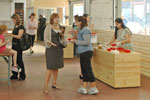
On Sept. 10, the PIttsburgh Public Market will open for business inside the Produce Terminal Building in the Strip District. More than 40 vendors will showcase their wares with everything from baked goods to artwork, barbecues to microbrews. Heidi Murrin | Tribune-Review
Starting a business is a lot less daunting for vendors when they’re paying $25 a day for a 10-foot-by-6-foot booth or $50 a day for a 10-foot-square booth.
“One of our challenges has been to get the concept across that, while this is not necessarily full-time, it’s also not a farmer’s market where you just show up and put your tablecloth down,” Cassell said. “It’s a little more permanent than that. So there is some planning involved for your booth. The booths are small, but from a financial perspective, I think it’s very accessible for a new business.
“We do have a lot of startups that are coming in,” she said. “That’s one of our goals, to incubate new businesses. And you know everything will be realized when they grow up and need a storefront, and can, hopefully, take an empty storefront in the neighborhood.”
Other vendors just want a little more visibility.
The Spice by Tamarind booth stocks Indian spices, snacks, chutneys, ready-to-eat meals and specialties like eggless cakes. Owner Prasad Potluri runs several Indian restaurants and small grocers in the region.
“It’s to make people aware of the restaurants and food,” Potluri said of the reason behind his participation.
For some, it’s simply a way to make it easier for customers to find their product.
Scott Smith, of East End Brewery, always assumed most of the sales for his Big Hop IPA and Black Strap Stout would be wholesale to bars and restaurants. But craft-beer fans just kept searching out the tiny, out-of-the-way brewery.
“We’re in an unmarked building in Homewood, and half our business is walk-in traffic,” Smith said.
Now, customers can sample Fat Gary Nut Brown Ale and Pedal Pale Ale at the Pittsburgh Public Market, and fill up their growlers to take home.
Not everything in the market is edible.
Babouche sells Moroccan crafts, jewelry, scarves and leather goods. Iron Eden is renowned for beautiful ironwork — flowers, trellises, sculpture — often made from recycled scrap metal. Jenn’s Jems features knit and crocheted items, and handmade jewelry.
Markets in other cities — like Cleveland’s West Side Market and Seattle’s Pike Place Market — have become first-day tourist attractions.
The Pittsburgh Public Market is starting on a much smaller scale, of course, but drawing new shoppers to the Strip is part of the plan.
“When we had Campos do a consumer market survey for us in 2006, at that time, we were planning for about 30,000 square feet,” Cassell said. “According to the consumer survey, it would add about 12,000 additional shoppers to the Strip every week. Now we’re scaled back in 10,000 square feet. But one of our goals is to increase the customer base for the entire Strip.”
Pittsburgh Public MarketWhen: Opens Friday, with Grand Opening Festivities Sept. 10-12
Hours: 9 a.m.-7 p.m. Fridays, 9 a.m.-5 p.m. Saturdays, 10 a.m.-4 p.m. Sundays
Where: 17th and Smallman streets, Strip District
Details: 412-281-4505 or website
-
E Properties & Development Restore Abandoned Lawrenceville Houses
Wednesday, September 01, 2010
E Properties and Development is nearing completion on the transformation of two blighted properties on 38th Street in Lawrenceville, contributing to the major revitalization efforts taking place on the hill between Butler Street and Penn Avenue.
The two connected townhouses at 234 38th Street sat neglected for some time, until E Properties and Development principal Emeka Onwugbenu purchased them last June.
“In terms of challenges, people suggested that the properties be demolished,” says Onwugbenu. “Our team of architects and engineers created value-based solutions that would restore the structural stability of each building while building on its architecture.”
Onwugbenu and architect Andrew Moss extended the foundations of the houses to create a more open environment with two added rooms, and installed bamboo floors throughout the buildings. They are also raising the second and third floors, and installing clear story windows, which will allow light to pour through the master bedrooms that will open into unique balcony decks overlooking downtown. The exterior, which is currently composed of vinyl siding, will be swapped out for cement board side material. Coldwell Banker has signed on to market the homes, which will start in the low $200,000 range, and are slated for move-in by Thanksgiving.
Onwugbenu, originally from Nigeria, attended Penn State for industrial engineering, and is currently in his final semester of the MBA program at CMU. He started E Properties and Development in 2007, in order to create unique value-added properties, which mix traditional design with a modern feel.
In addition to the homes at 234 38th Street, architect Andrew Moss is currently building his dream home one block away at 221 38th Street. Two other homes, at 236 and 238 38th Street, are currently being renovated by private owners, within steps of the 234 buildings.
Sign up to receive Pop City each week.
Source: Emeka Onwugbenu, principal of E Properties and Development
Writer: John FarleyImage courtesy Emeka Onwugbenu
-
Thank You Summer Interns
PHLF News
July 29, 2011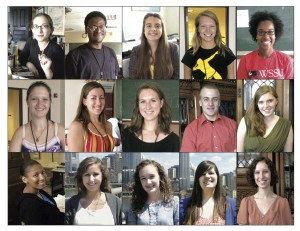
Since March, PHLF has involved 15 students (high school, college, and graduates) in its educational programs and preservation activities. As volunteers with PHLF, each student decides how many hours a week and what days h e/she is able to help out. Once here, interns assist with school tours, workshops for teachers, research and archival assignments, and main street programs. And, if they enjoy being with students, they help out with CampDEC, a 2 0-day adventure with middle school students in the Pittsburgh Public School’s Summer Dreamers Academy. Thank you everyone for your help and effort!
As a result of their experiences, interns add to their portfolios and gain a new (or deeper) appreciation for Pittsburgh’s architecture and history and for the economic, social, and cultural benefits of historic preservation. Intern comments on the value of their experiences include the following:
- Julie Edwards: “PHLF has given me a deeper understanding of Pittsburgh’s extensive architectural heritage and a greater appreciation for the built environment.”
- Alyssa Malobicky: “Thank you for welcoming me back to PHLF again. The hands-on involvement in the day-to-day activities of PHLF teaches me so much. I appreciate all that PHLF does to keep Pittsburgh a special place.”
- Ashley Moore: “Through interning with PHLF, I have a new-found appreciation for Pittsburgh. It is amazing how evidence of the city’s changes was here long before I was and may be here long after I am gone.”
- Barrett Reiter: “My experiences with the educational, non-profit portion of PHLF have taught me that educating future generations is as important as preserving the accomplishments of those past. Without understanding and a personal connection to the built environment our unique history is too easily lost.”
- Shane Martin: “My time with PHLF has broadened my horizons on subjects ranging from historic preservation to urban design and the strenuous human effort put into the systems that hold our society together. I was fortunate to work alongside the very minds that ensure our city’s rich history and put forth my own efforts at planning the future.”
We thank the following 15 people (all pictured above) who volunteered their time and talent to PHLF:
- Lauren Borrelli, Penn State University (Architecture)
- Emily Bush, Miami University of Ohio (History/Journalism)
- Julie Edwards, Kent State University graduate (Interior Design)
- Michal Gould, University of Pittsburgh
- Stacy Litwinowicz, West Virginia University (Interior Design)
- Samantha Mabe, Clemson University (Architecture)
- Alyssa Malobicky, Virginia Tech (Landscape Architecture)
- Shane Martin, University of Pittsburgh (Urban Studies/Architectural Studies)
- Grace Meloy, University of Pittsburgh (Architectural Studies/Civil Engineering)
10. Ashley Moore, University of North Carolina graduate (Masters of Urban Design)
11. Barrett Reiter, University of Pittsburgh ( History/Political Science/Historic Preservation)
12. Katherine Schmotzer, Baldwin High School
13. Emily VanBuren, Slippery Rock University––Masters (History)
14. Camden Yandel, Saint Vincent College (Graphic Design)
15. Sydney Zalewski, Carnegie Mellon University (Architecture/Photography)
To learn more about PHLF’s volunteer internship program click here.
-
Challenge Grant Generates $100,000 for Historic Religious Properties Program
PHLF News
Wednesday, August 04, 2010Thanks to $25,000 in challenge grants from two anonymous donors, The Pittsburgh History and Landmarks Foundation is reviving its recently troubled Historic Religious Properties Program, which provides matching grants to help congregations perform exterior maintenance on their facilities.
“Since 1997, we’ve been giving an average of 70 to 80 thousand dollars a year in grants. When we hit economic hard times in 2010, we suspended the grant program, because there just wasn’t enough money,” says Carole Malakoff, coordinator for the religious properties program.
With the grant program in limbo, two donors stepped up three weeks ago, giving the foundation 60 days to match the grants. The foundation’s President put up $12,500, and over 288 donors contributed gifts totaling $62,710, bringing the total grant package available for the 2011 grant cycle to over $100,210, making this the most successful annual appeal in the Pittsburgh History and Landmark Foundation’s 46 year history.
Applications for grants will be due by December 1, 2010, and provide matching grants up to $10,000 to Allegheny County churches that are over 50 years old.
“Over the years, the majority of our grants have gone to stained glass window work, roof and gutter repair, and masonry work,” says Malakoff.
As a result of the generous outpouring of support, PHLF has decided to host a technical assistance workshop on September 20 at the Calvary Episcopal Church in Shadyside. Experts will provide demonstrations to members of congregations on green building, handicap accessibility, and all that it entails to maintain a historic building.
“We sent out a letter in June to see if there was enough interest, and we’ve had 30 congregations call to say they are interested. So, we’ve had a wonderful response, and we’re still accepting people to come,” says Malakoff.
The workshops go from 10:30 a.m. to two p.m. Interested parties can contact Carole Malakoff at 412-321-3612.
Sign up to receive Pop City each week.
Source: Carole Malakoff, coordinator for PHLF Religious Properties Program
Writer: John Farley

